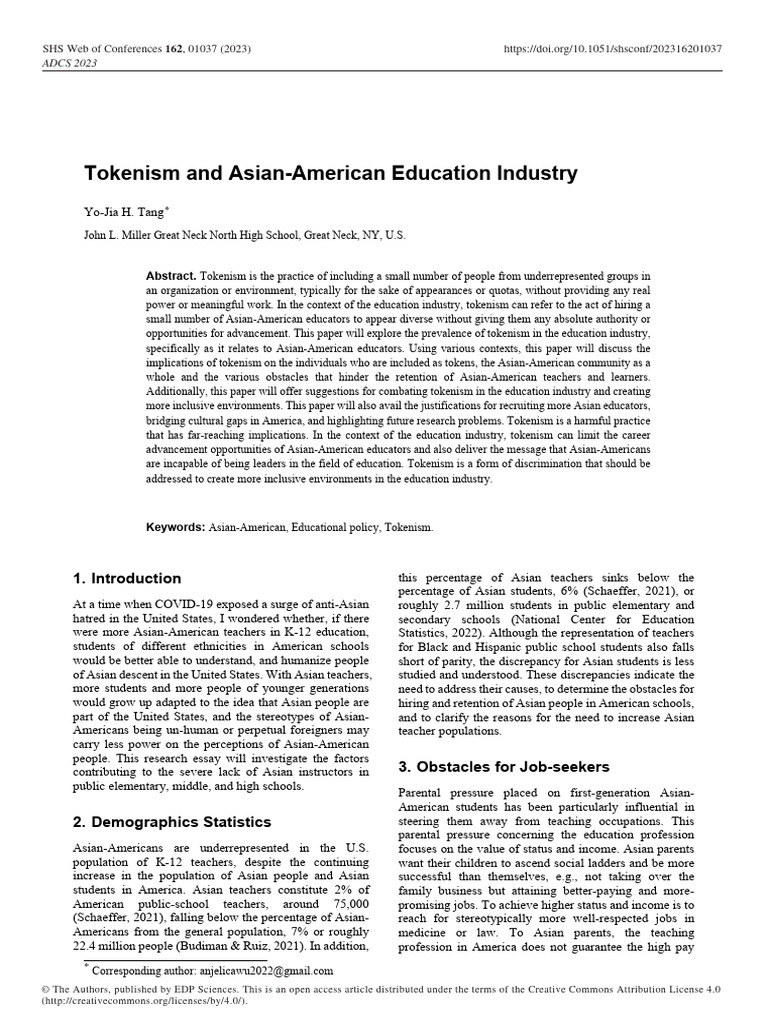Beyond Tokenism: The Fight For True Representation In Asian And Asian American Media

Table of Contents
The Persisting Problem of Stereotypes and Tokenism
The media's portrayal of Asians and Asian Americans is frequently marred by harmful stereotypes that limit the depth and complexity of their on-screen presence. These stereotypes often reduce individuals to one-dimensional caricatures, hindering genuine understanding and empathy.
-
The Model Minority Myth: This stereotype paints all Asians and Asian Americans as inherently intelligent, hardworking, and successful, ignoring the struggles faced by many within the community due to systemic inequalities and discrimination. It sets up unrealistic expectations and creates pressure to conform to an idealized image.
-
The Perpetually Foreign Persona: Asians and Asian Americans are often depicted as perpetually foreign, unable to fully assimilate into American society. This reinforces the "othering" of these communities and perpetuates xenophobia. This is often displayed through broken English or exaggerated accents, contributing to the marginalization of their experiences.
-
Hypersexualization: The fetishization of Asian women and the portrayal of Asian men as emasculated or asexual are common and damaging stereotypes that reduce individuals to objects of desire or ridicule.
Examples of tokenism and harmful stereotypes:
- The single Asian character in a predominantly white cast, often serving as a "diversity quota" without any meaningful storyline or character development.
- The use of exaggerated accents and stereotypical behaviors to create comedic relief, further reinforcing harmful tropes.
- The limited range of roles offered to Asian and Asian American actors, frequently confined to limited and stereotypical characters. This restricts opportunities for showcasing their full acting range and diversity.
The impact of these stereotypes is significant. They shape public perception, reinforcing prejudice and limiting opportunities for Asian and Asian American individuals. These representations affect self-esteem, social acceptance, and the understanding of their place in society.
The Need for Authentic Storytelling and Diverse Voices
Moving beyond tokenism requires a fundamental shift in the approach to Asian and Asian American representation in media. We need to see a move towards authentic storytelling that showcases the incredible diversity of experiences, cultures, and perspectives within these communities. This means:
-
Exploring complex narratives: Moving beyond simplistic tropes and exploring complex themes, conflicts, and character arcs that reflect the realities of Asian and Asian American life. This includes portraying characters that are flawed, complex, and multi-dimensional, not just fitting into pre-conceived stereotypes.
-
Amplifying diverse voices: Giving a platform to a wide range of Asian and Asian American experiences, highlighting the differences between various ethnicities and cultural backgrounds within the Asian diaspora.
Examples of successful authentic representation:
-
Shows like Fresh Off the Boat and Everything Everywhere All at Once demonstrate the possibility of nuanced and relatable portrayals of Asian and Asian American families and individuals.
-
The work of independent filmmakers and creators often provides more authentic and diverse stories, reflecting the experiences of specific communities often marginalized by mainstream productions.
The role of Asian and Asian American creators behind the camera (directors, writers, producers) is crucial. Their unique perspectives and lived experiences are vital for ensuring authenticity and creating narratives that resonate deeply with the target audience. This ensures stories aren't just told about the community, but by the community.
Strategies for Achieving True Representation
Achieving true representation requires conscious and deliberate effort from the media industry. Concrete steps must be taken to foster inclusion and authenticity:
-
Diverse Hiring Practices: Actively recruiting and hiring Asian and Asian American writers, directors, producers, actors, and crew members at all levels of production. This means creating inclusive environments where talent is recognized on merit, regardless of ethnicity.
-
Inclusive Story Development: Involving Asian and Asian American communities in the development of stories from the outset, ensuring that narratives are authentic and reflect the perspectives of those being portrayed.
-
Community Engagement: Collaborating with community organizations and leaders to understand the unique challenges and opportunities facing Asian and Asian American communities.
Specific actions to promote inclusion:
- Advocating for more Asian and Asian American creatives in leadership roles, providing them with the power to shape narratives and influence casting decisions.
- Implementing blind auditions to combat unconscious bias in casting.
- Supporting independent films and projects that center Asian and Asian American experiences, often overlooked by larger production companies.
These steps will not only improve representation but also enrich the media landscape as a whole.
The Role of Consumers and Activism in Driving Change
Consumers have significant power to influence media production through their choices and actions. Supporting projects with authentic representation, and actively boycotting those that perpetuate harmful stereotypes sends a clear message to the industry.
-
Demand authentic stories: Support media with diverse casts, nuanced narratives, and complex characters that reflect the richness of Asian and Asian American experiences.
-
Call out harmful stereotypes: Speak out against media that uses harmful stereotypes, helping to raise awareness and encourage more responsible representations.
Examples of successful audience campaigns:
-
Numerous social media campaigns highlighting instances of inaccurate or harmful portrayals have prompted studios and networks to reconsider their approach.
-
Organized boycotts of media have demonstrated the power of collective consumer action.
Activism and advocacy groups play a crucial role in pushing for change. These organizations provide resources and support to individuals and communities striving for better representation. Supporting these organizations is a vital step in driving progress.
Moving Beyond Tokenism Towards Authentic Asian and Asian American Representation
In conclusion, genuine and diverse Asian and Asian American representation in media is not merely a matter of inclusion; it's essential for creating a fair and equitable society. Moving beyond tokenism requires concerted effort from media creators, consumers, and activists. By demanding better, supporting better, and creating better stories, we can accurately reflect the richness and diversity of Asian and Asian American communities. Let's continue the fight for authentic Asian and Asian American representation in media. Demand better, support better, and create better stories that reflect the richness and diversity of our communities.

Featured Posts
-
 Duplantis Diamond League Debut A New Era In Pole Vaulting
May 11, 2025
Duplantis Diamond League Debut A New Era In Pole Vaulting
May 11, 2025 -
 Exclusive Look Chinas Security Focus In Critical U S Trade Discussions
May 11, 2025
Exclusive Look Chinas Security Focus In Critical U S Trade Discussions
May 11, 2025 -
 A Guide To Meeting Shane Lowry Fan Experiences
May 11, 2025
A Guide To Meeting Shane Lowry Fan Experiences
May 11, 2025 -
 Nba Sixth Man Of The Year Payton Pritchard Makes History For The Celtics
May 11, 2025
Nba Sixth Man Of The Year Payton Pritchard Makes History For The Celtics
May 11, 2025 -
 Fin D Une Epoque Le Depart De Thomas Mueller Du Bayern Munich
May 11, 2025
Fin D Une Epoque Le Depart De Thomas Mueller Du Bayern Munich
May 11, 2025
